Formula One: 1987 Brazilian GP
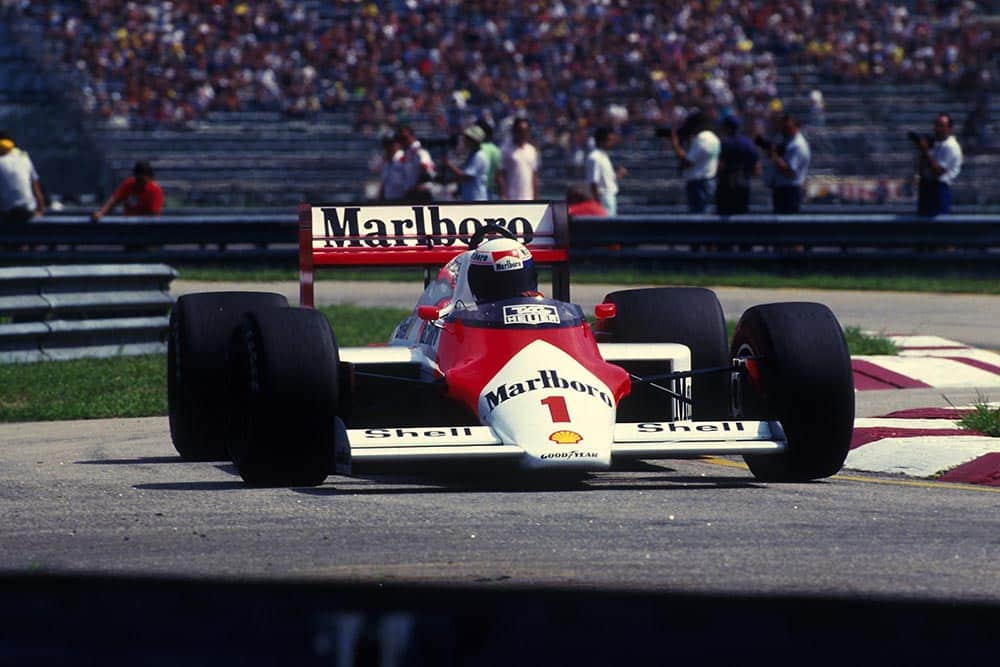
Winner Alain Prost in his McLaren MP4/3.
© Motorsport Images
A joy to behold
One of Grand Prix racing’s most endearing characteristics is its unpredictability. Just when one driver or team seems to have established a set pattern of dominance, somebody close comes along and upturns our careful calculations. Yet at Rio on April 12, twice World Champion Alain Prost proved to the world that, whatever anybody else might be doing, his presence as the driver of the 1980s looks set to be sustained through a fourth consecutive season with the McLaren International team. Writing an over-view of any particular race is a difficult task immediately after it has taken place. Yet even though the specific lessons of the 1987 Championship-opener have yet to fall into place, Prost’s role as F l’s most glittering star has long since slipped into pin-sharp focus.
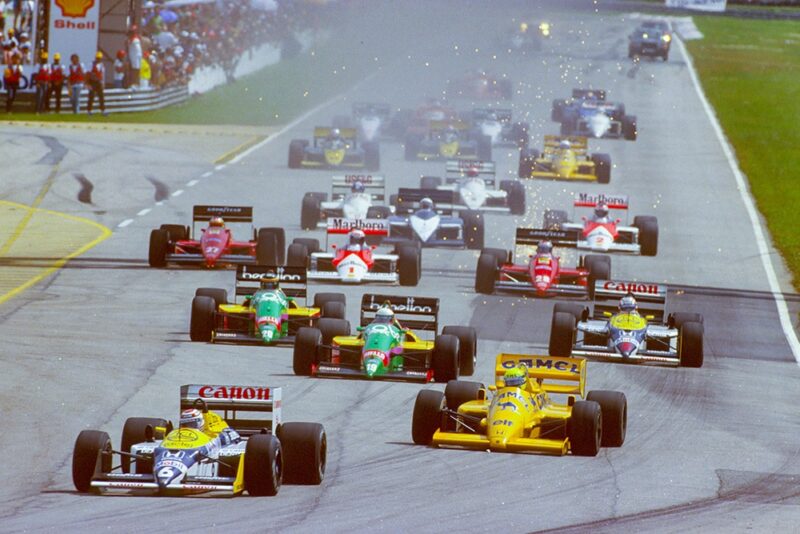
Nelson Piquet (Williams FW11B Honda) leads Ayrton Senna (Lotus 99T Honda), Teo Fabi and Thierry Boutsen (both Benetton B187 Ford’s) and Nigel Mansell (Williams FW11B Honda) at the start.
© Motorsport Images
With a week to go before the race, Teo Fabi’s new Benetton-Ford B187 had been the talking point after lapping a few seconds clear of the field in the last pre-season test at the Brazilian track. The night before the race, Williams-Honda seemed to have the whole affair tucked up in advance, Nigel Mansell and Nelson Piquet, monopolising the front row, almost two seconds ahead of their rivals. But, if you had examined the way things were developing in fine detail you would have seen that Prost was an ever-present threat.
Most drivers who have won a World Championship suffer from what Jackie Stewart once described as “post-championship blues”. After the massive surge of effort required to sustain a title challenge, the following year frequently sees an unconscious, but perceptible, dropping off in form. A touch of relaxation creeps in, bred by relief at the success of the previous year’s efforts. Stewart admits it happened to him and so does Niki Lauda. It probably didn’t happen to Juan Manuel Fangio, nor to Jim Clark. And it certainly hasn’t happened to Prost.
When McLaren’s gifted chief designer John Barnard left the team to set up Ferrari’s new British-based engineering office, many people thought that the McLaren spell might be broken for Prost. The Frenchman admired and respected Barnard, and was obviously concerned over his departure. But McLaren pressed on to build the revolutionary MP4/3 which ran for the first time in anger at the second Rio test. It may have looked quite similar to the 1986 MP4/2C, but it was a new car conforming to a totally new set of technical regulations.
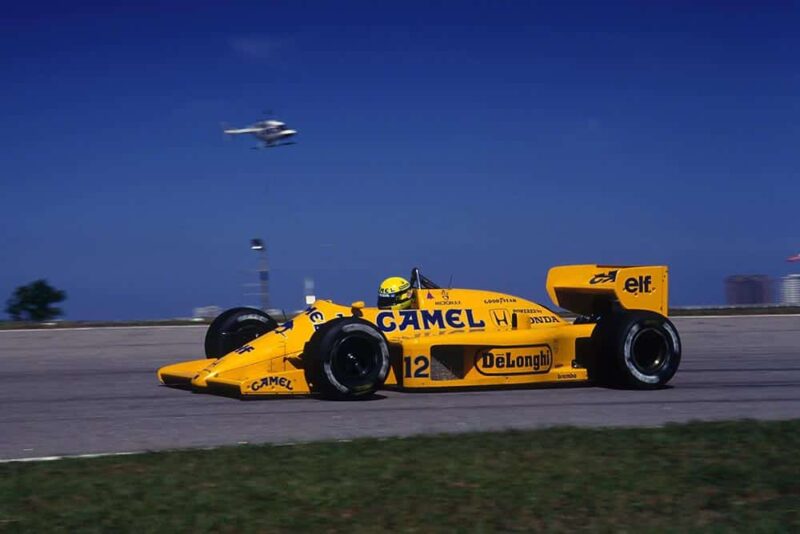
Ayrton Senna in a Lotus 99t retired with engine failure.
© Motorsport Images
Not only did its monocoque have a smaller fuel cell purpose-built to contain 195 litres, but its Porsche-built TAG V6 turbo engine had been carefully revised, the German engineers and McLaren technicianu giving a lot of thought as to how best to incorporate the mandatory boost control valves which are required by the 1987 F1 technical regulations as a means of limiting power output in qualifying.
With the maximum boost permissible being set at 4 bar, McLaren did all its calculations and came to a reasoned conclusion. Satisfied that its V6 engines never ran anywhere near 4 bar in race trim, they decided that the best thing would be never to operate near the point at which the valve would be activated. Thus the McLaren-TAG/Porsche operated throughout the Brazilian GP weekend at no more than 3.6 bar.
It is therefore no surprise to report that the team had no problems at all with its boost control valves, while those teams which tended to use them a bit like a rev limiter (i.e. forcing as much boost pressure through the engine as possible until the valve was activated) suffered a spate of problems with the valves going wrong. “My pop-off valve cut in at 3.2 bar, and I didn’t have any power as a result” is certain to become one of the classic driver excuses of the 1987 season.
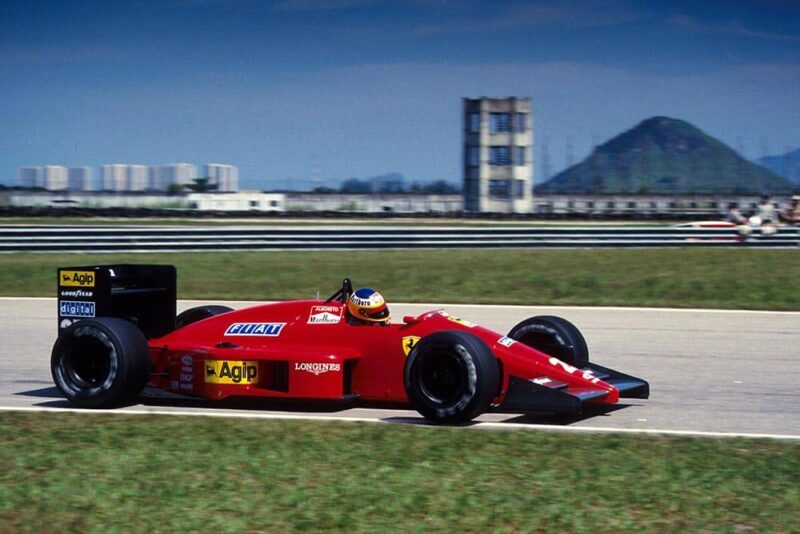
Michele Alboreto in his Ferrari F187.
© Motorsport Images
However, from the outset, Prost could not be ignored. He drove a brand new MP4/3 which had never turned a wheel, the test car being relegated to the role of team spare. He qualified fifth on the grid with the bare minimum of technical troubles and, significantly, was the only non-Honda-engined car to top 190mph on the long Autodromo Riocentro back straight.
Meanwhile, the Williams FW11Bs looked set to run away from their opposition. Nigel Mansell and Nelson Piquet made the battle for pole position their own personal feud, the Brazilian just pipping England’s ace in the last five minutes of Friday qualifying, but Nigel reasserting himself on Saturday. Ayrton Senna was third in the ambitious new Lotus-Honda 99T, fitted with computer-controlled active suspension designed to sustain a constant ride height whatever the car’s attitude on the circuit, and Teo Fabi qualified fourth in the new Benetton.
Alongside Prost on row three was Belgian Thierry Boutsen in the second Benetton, and the fourth row saw Gerhard Berger in the new Ferrari F187 lining up along side Derek Warwick in the Arrows A10, its “upright” BMW engines dubbed “Megatrons” to please the team’s new sponsors. Other interesting, new and not-so-newcomers included Japan’s first full-time GP driver, Satoru Nakaiima, in the other Lotus-Honda and the nomination by Ecclestone of Andrea de Cesaris to drive the second Brabham BT56 alongside Riccardo Patrese.
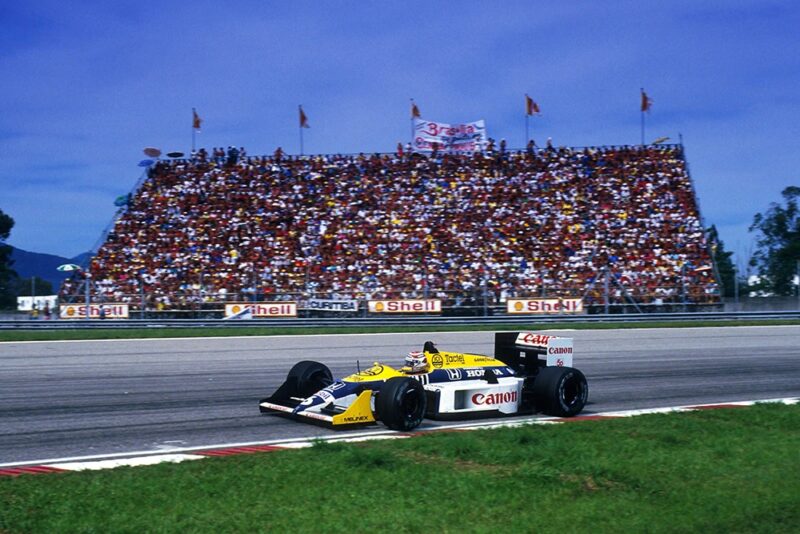
Nelson Piquet at the wheel of his Williams FW11B.
© Motorsport Images
For better or worse and in anticipation of the new 3.5-litre naturally-aspirated Formula One coming along in 1989, we also had a non-turbo “Group B” in which Ken Tyrrell’s cars for Jonathan Palmer and Philippe Streiff looked well in control.
The first race of the Grand Prix year was run in absolutely searing conditions of subtropicitl sunshine, the ambient temperature nudging 35deg C (about 96deg F). From the start it looked as though Piquet might run away with his home race, the Brazilian leading fellow countryman Senna for the first few laps after Mansell finished lap one fifth. But the Williams-Hondas were both destined to run into major overheating problems.
Piquet was in the pits at the end of lap six having paper debris cleaned out of his radiator intake ducts and Mansell was to be similarly hampered from early on. What was rather strange, however, was the fact that the temperatures hardly came down at all after the ducts were cleared. When Prost had a similar problem, the temperatures on the TAG V6 dropped back reassuringly once the unrestrcted airflovv resumed. That tended to point a fault in the Honda engine’s cooling system, which was scheduled for detailed scrutiny before the next race in Europe.
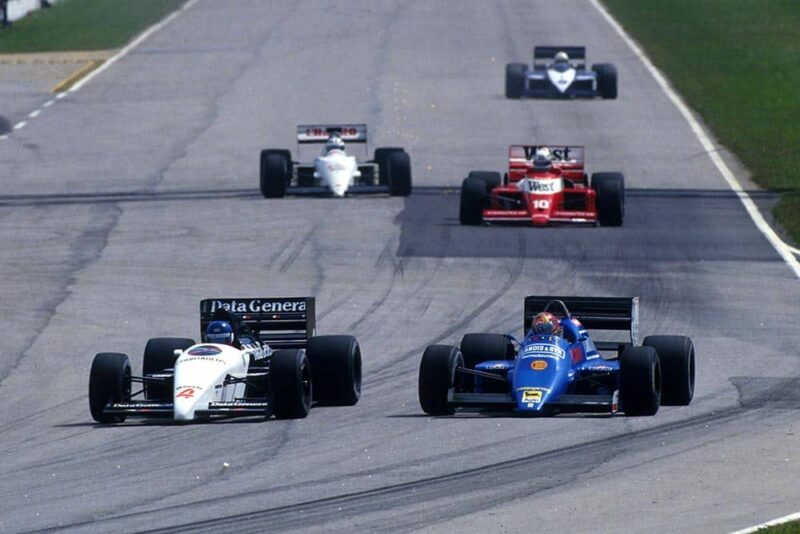
Phillippe Streiff (FRA) Tyrrell DG016 passes Alex Caffi (ITA) Osella FA11.
© Motorsport Images
Prost hung on with the leaders from the start, finishing lap one in sixth place. By lap 11 he was second behind Senna and he took the lead for the first time on lap 13. He dropped to fifth when he stopped for tyres on lap 16, but fought back to the front on lap 21. From then on, the World Champion held the lead for the remaining 40 laps, even staying ahead through a second tyre stop. He never looked ruffled, the car performed perfectly, he conserved his tyres magnificently. It was a joy to behold.
Meanwhile, the supporting cast encountered endless problems. The Williams-Hondas eventually wound up a disappointing second (Piquet) and sixth (Mansell), while a host of minor gremlins blighted the Benetton challenge. Fabi was sitting right behind the leaders when his Ford engine began misfiring, then it lost boost pressure and he retired with turbo failure.
The two Ferrari drivers hung on as best they could, the new F187 with its compact 90° V6 engine not looking significantly better than the unloved 1986 car over the bumps. Despite grappling with a fourth gear which proved reluctant to stay engaged, Berger hauled up onto the tail of team-mate Alboreto in the closing stages of the race, surging by to claim fourth place on the long back straight just as the Italian’s car lost the vertical “fences” beneath its aerodynamic rear undertray in a spectacular sheet of sparks. A few laps after being passed by the Austrian, Alboreto spun off into retirement just before the left-hand hairpin onto the back straight.
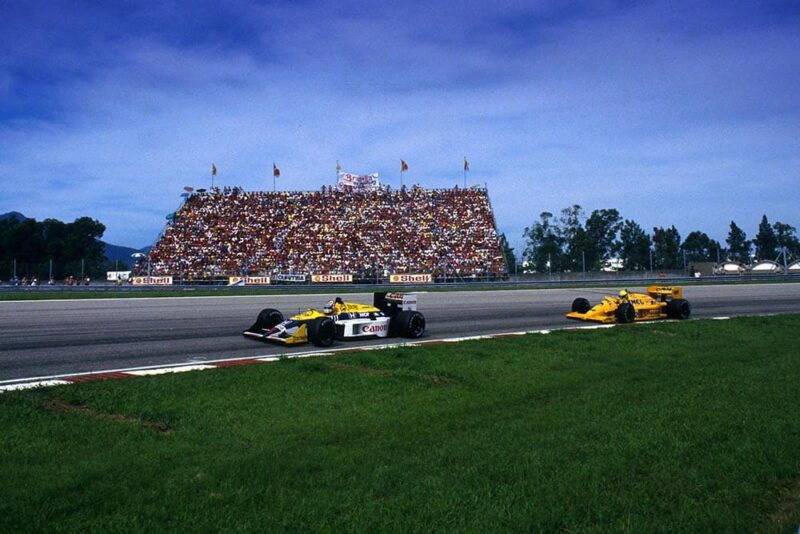
Nigel Mansell in his Williams FW11B.
© Motorsport Images
After a cautious and conservative performance in qualifying, McLaren’s new number two driver Stefan Johansson did absolutely everything expected of him, to come home third in his first race for the team. There was a time when he was running second, albeit some distance behind the World Champion, but eventually he yielded to Piquet’s pressure.
In the non-turbo division, the new Tyrrells finished first and second, Palmer one lap ahead of an extremely sick Philippe Streiff who chose to race the spare car after suffering with a persistent misfire throughout practice. At this early stage in “Division 2”, there are no real challengers to Uncle Ken’s cars. The works March, based round an F3000 monocoque and consequently with insufficient tankage to go the full race distance, had to be withdrawn on the morning of the race after its second major engine failure in as many lays. The team needed to conserve its third Cosworth DFZ V8 for testing its first pukka F1 chassis, which promises to be ready for the San Marino GP at Imola next month. From that point, I expect Ivan Capelli to give the Tyrrells something to think about.
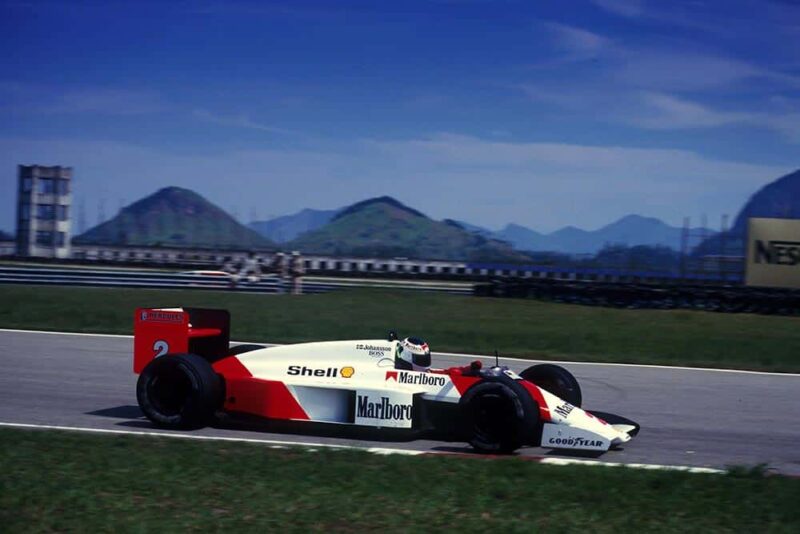
Stefan Johansson driving a McLaren MP4/3 to 3rd place.
© Motorsport Images
Meanwhile, Prost had won his third Brazilian Grand Prix in four years for McLaren, the 26th triumph of his F1 Championship career. There is nothing to suggest he is anything less than totally committed to winning a third World Championship, topping Jackie Stewart’s record of 27 Grand Prix victories, and establishing himself for good as one of the greatest drivers in the history of the sport.
Incredibly, there are still people who have reservations about the diminutive Frenchman. Perhaps it is because he is so unobtrusive, handling his car with a delicacy and mechanical sympathy that makes him unexciting to watch. Why that should cause people to think any the less of him is something I have never been able to fathom. At Rio this year he shone like the star he unquestionably is. The Prost/McLaren partnership is on the verge of passing into motor racing legend. AH
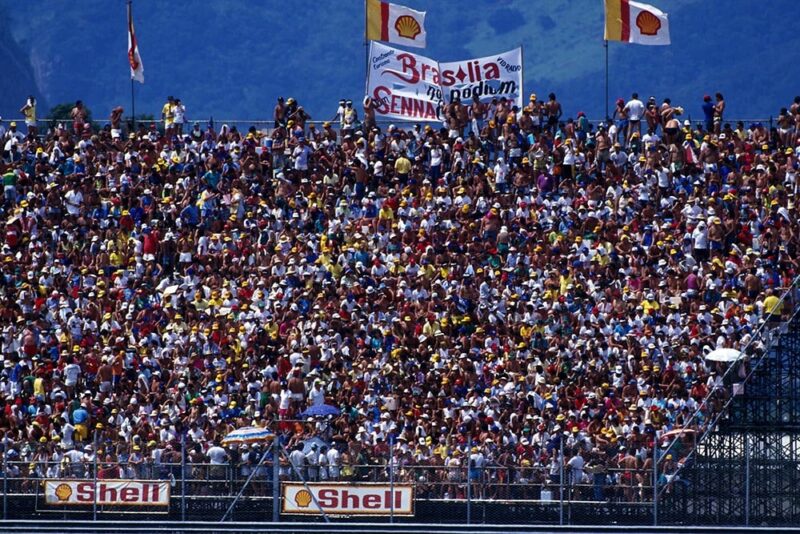
Fans crowd the stands at the Brazilian Grand Prix.
© Motorsport Images
